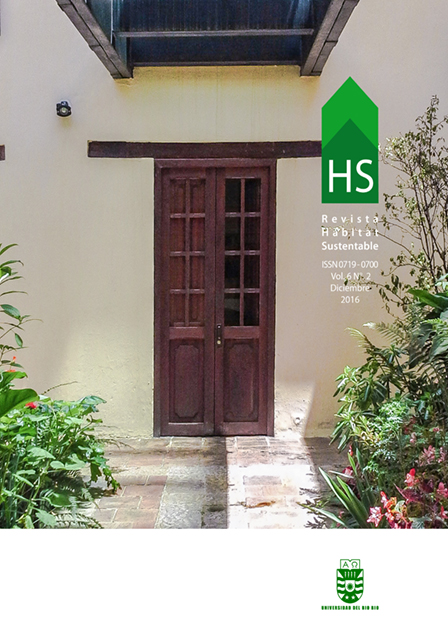Estimación del riesgo de sobrecalentamiento y del potencial de refrigeración por ventilación natural de viviendas unifamiliares en ciudades costeras de Chile.
Palavras-chave:
ventilación, refrigeración, viviendasResumo
Este trabajo presenta una propuesta de evaluación de la demanda de refrigeración y de la capacidad de refrigeración pasiva por ventilación natural en viviendas sociales. La propuesta se fundamenta en la EN ISO 13790:2008 que utiliza una metodología casi estacionaria de cálculo. Se evalúa una vivienda con ventanas de doble batiente en las dos fachadas, en las diferentes orientaciones N-S, E-O, NO-SE y NE-SO. Se suponen dos posibles caracterizaciones del interior: poco conectado y muy conectado. Los emplazamientos considerados presentan una variedad climática importante, desde los desiertos del norte hasta los climas con variabilidad estacional más marcada del centro- sur del País. Las ciudades consideradas en el estudio son: Arica, Iquique, Antofagasta, La Serena, Valparaíso, Concepción, Valdivia y Puerto Montt. Los resultados muestran la presencia de demanda de refrigeración en la mayoría de los emplazamientos analizados y una capacidad de evacuar el calor por ventilación natural media variable entre el 20% y el 80% de esta demanda, demostrando la importancia de la utilización de las brisas para la refrigeración de edificio y ciudades del País.
Downloads
Referências
BUSTAMANTE, Waldo, DE HERDE, André, ENCINAS, Felipe. Analysis of office building thermal performance in different districts of the Metropolitan Area, Chile. Revista de la Construcción, vol. 10, (no 1): pp. 64-77,April 2011.
EDWARD,ng. Policies and technical guidelines for urban planning of high- density cities – air ventilation assessment (AVA) of Hong Kong. Building and Environment , vol. 44, (no 7), p. 1478-1488.July 2009.
KOLOKOTRONI, Maria, GIANNITSTARIS, Ioannis, WATKINS, Richard. The effect of the London urban heat island on building summer cooling demand and night ventilation strategies. Solar Energy, vol. 80, (no 4): pp. 383-392, April 2006.
GALDERISI, Anna, MAZZEO, Giuseppe, PINTO, Fulvia. Cities Dealing with Energy Issues and Climate-Related Impacts: Approaches, Strategies and Tools for a Sustainable Urban Development. En: Smart Energy in the Smart City. Urban Planning for a Sustainable Future. Springer Ed. 2016, pp.199- 217
GHIAUS, Christian, ALLARD, Francis, SANTAMOURIS, Matheos, GEORGIAKIS, Constatinus, NICOL, Fergus. Urban environment influence on natural ventilation potential. Building and Environment 2006, vol. 4, (no 1): p. 395-406.2006.
GROSSO, Mario. Il raffrescamento passivo degli edifici. Maggioli Ed. Milano 2011
HOLMES, Michael, HACKER, Jacob. Climate change, thermal comfort and energy: Meeting the design challenges of the 21th Century, Energy and Buildings 2007, vol. 39, (n° 7): p. 802-814.2007.
HEISLEBERG, Per, SANDBERG, Mats. Evaluation of Discharge Coefficients for Window Openings in Wind Driven Natural Ventilation. International Journal of Ventilation, vol.5, (no 1): pp. 43-52.March 2016.
ISO 13790/2008 (rev. 2012) Energy performance of buildings - Calculation of energy use for space heating and cooling.
LEBASSI-HABTEZION, Bereket, GONZÁLEZ, Jorge, BORNSTEIN, Robert. Modeled large-scale warming impacts on summer California coastal cooling trends. Journal of Geophysical Research, vol. 116, (no D20): pp. 1-11, 2011.
LI, Haiquin. KANAMITSU Masao, HONG, Song-You, YOSHIMURA, Kei, CAYAN, Daniel, MISRA, Vasubandhu, SUN, Liquiang. Proyected climate change scenario over California by a regional ocean-atmosphere coupled model system. Cimatic Change, vol.122,( no 4): pp. 609-619, december 2013.
MINVU, Manual de aplicación de la reglamentación térmica.[en línea], 2008. Disponible en:
MCLEOD, Robert. HOPFE, Cristina, KWAN, Alan. An investigation into future performance and overheating risks in passive house dwellings. Building and Environment, (no 70), p. 189-209.2013
OLIVEIRA, Marta, CAMELO, Susana, GONÇALVES, Helder. Assessment of the Portugese building thermal code: Newly revised requirements for cooling energy needs used to prevent the overheating of buildings in the summer. Energy, vol. 36, (no 5): p. 3262-3271, May 2011.
PALME, Massimo. Energy certification process in Chile: steps to dynamic simulation of buildings’ energy performance. En: Proceedings of the Passive and Low Energy Architecture Conference, (Amehdabad, India, December 2014).
PALME, Massimo. The possible shift between heating and cooling demand of buildings under climate change conditions: are some of the mitigation policies wrongly understood? En: Mediterranean Green Buildings and Renewable Energy. Springer Ed. In press
PALME, Massimo, VÁSQUEZ, Amanda. Energy labeling of residential buildings in Chile: comparing steady-state evaluations and dynamical simulation results. En: Proceedings of the Building Simulation Conference, (Hyderabad, India, December 2015).
PALME, Massimo, ISALGUÉ, Antonio, COCH, Helena, SERRA, Rafael. Energy consumption and robustness of buildings. En : Proceedings of the Central Europe towards Sustainable Buildings Conference,( Praga, República Checa, June 2010).
SANTAMOURIS, Matheos, WOUTERS, Peter. Building Ventilaton: The State of Art., USA.Earthscan, 2006
SANTAMOURIS, Matheos, CARTALIS, Constantinos, SYNNEFA, Afroditi, KOLOKOTSA, Dania. On the impact of urban heat island and global warming on the power demand and electricity consumption of buildings – a review. Energy and Buildings , vol. 98, :pp. 119-124 ,2015.
TOLEDO, Linda, CROPPER, Paul, WRIGHT, Andrew. Unintended consequences of sustainable architecture: Evaluating overheating risks in new dwellings. En: Proceedings of the Passive and Low Energy Architecture Conference, Los Angeles, USA, July 2016.
Downloads
Publicado
Como Citar
Edição
Secção
Licença
O conteúdo dos artigos publicados em cada número do Habitat Sustentável é da exclusiva responsabilidade dos autores e não representa necessariamente o pensamento ou compromete a opinião da Universidad del Bío-Bío.
Os autores mantêm os seus direitos de autor e concedem à revista o direito de primeira publicação da sua obra, que está simultaneamente sujeita à Licença de Atribuição Creative Commons CC BY-SA que permite a outros partilhar, transformar ou criar novo material a partir desta obra para fins não comerciais, desde que a autoria e a primeira publicação nesta revista sejam reconhecidas, e as suas novas criações sejam licenciadas sob os mesmos termos.











 Programa de Informação Científica/Concurso Fondos de Publicación de Revistas Científicas 2018/ Proyecto Mejoramiento de Visibilidad de Revistas UBB (Código:FP180007)
Programa de Informação Científica/Concurso Fondos de Publicación de Revistas Científicas 2018/ Proyecto Mejoramiento de Visibilidad de Revistas UBB (Código:FP180007)





